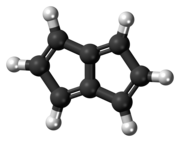|
Pentalene
Pentalene is a polycyclic hydrocarbon composed of two fused cyclopentadiene rings.[2] It has chemical formula C8H6. It is antiaromatic, because it has 4n π electrons where n is any integer. For this reason it dimerizes even at temperatures as low as −100 °C.[3][4] The derivative 1,3,5-tri-tert-butylpentalene was synthesized in 1973.[5] Because of the tert-butyl substituents this compound is thermally stable. Pentalenes can also be stabilized by benzannulation for example in the compounds benzopentalene and dibenzopentalene.[2] Dilithium pentalenide was isolated in 1962, long before pentalene itself in 1997.[6] It is prepared from reaction of dihydropentalene (pyrolysis of an isomer of dicyclopentadiene) with n-butyllithium in solution and forms a stable salt. In accordance with its structure proton NMR shows 2 signals in a 2 to 1 ratio. The addition of two electrons removes the antiaromaticity; it becomes a planar 10π-electron aromatic species and is thus a bicyclic analogue of the cyclooctatetraene (COT) dianion C8H2−8. The dianion can also be considered as two fused cyclopentadienyl rings, and has been used as a ligand in organometallic chemistry to stabilise many types of mono- and bimetallic complexes, including those containing multiple metal-metal bonds, and anti-bimetallics with extremely high levels of electronic communication between the centers.[7] See alsoReferences
|
||||||||||||||||||||||||||||||||||||||
Portal di Ensiklopedia Dunia


